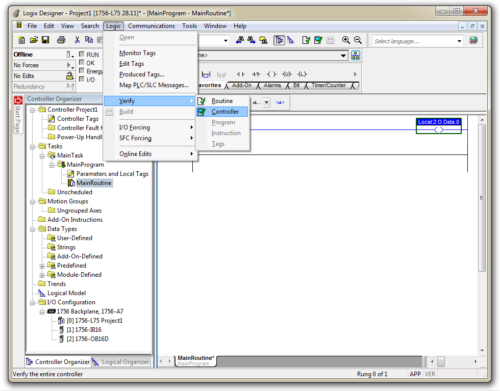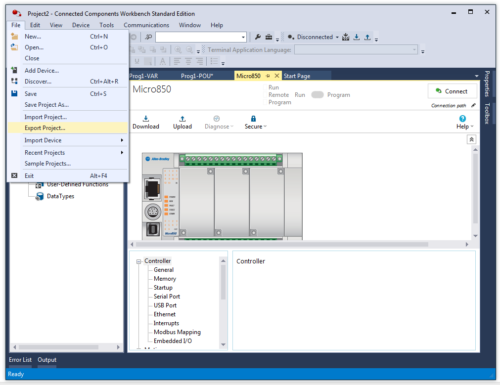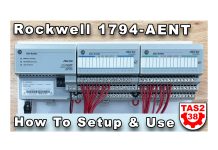
If you’re familiar with Studio 5000 (or RSLogix 5000) and find yourself in the position of having to write a program for a Micro800, below are seven CCW tips to help you get started:
1) Controller Organizer:
In Studio 5000 Logix Designer, the Controller Organizer starts with the Controller itself under which Controller Tags are nested, followed by Tasks with Programs, Tags, and Routines nested underneath:
 CCW’s Project Organizer starts with the Controller, then Programs with Tags and Routines blow them, followed by Globals:
CCW’s Project Organizer starts with the Controller, then Programs with Tags and Routines blow them, followed by Globals:
In Studio 5000 there are Controller Tags which are Globally Scoped, as well as Parameters and Local Tags (formerly Program Tags) found in each Program and which can be Local or Globally Scoped:
 In CCW, each Program has its own Local Variables, and the entire project also contains Global Variables:
In CCW, each Program has its own Local Variables, and the entire project also contains Global Variables:
Studio 5000 has a powerful “drop-down” Tag Browser which is accessible by selecting the address field as shown below:
 The “drop down” Variable Selector in CCW, which is also accessible by selecting the address field, is merely a simple linear list that I’ve not found much use for aside from selecting I/O addresses:
The “drop down” Variable Selector in CCW, which is also accessible by selecting the address field, is merely a simple linear list that I’ve not found much use for aside from selecting I/O addresses:
 Instead, I prefer the tabbed “pop-up” Variable Selector which is accessed by double clicking on the the instruction instead of clicking on the address field:
Instead, I prefer the tabbed “pop-up” Variable Selector which is accessed by double clicking on the the instruction instead of clicking on the address field:
In Studio 5000 it’s easy to choose your project’s path by selecting the RSWho button on the Path toolbar:
 In CCW, setting your project path is a little more involved.
In CCW, setting your project path is a little more involved.
- First double click on the Controller in the Project Organizer.
- The select the Connection Path link under the Connect button on the top right of the window.
- Finally, select Browse from the Set Connect Path pop-up window to launch the Connection Browser with RSWho window:
Verifying your entire project in Studio 5000 can be completed by using the menu as shown, or selecting the Toolbar button with the Computer with Green Check-mark icon:
 Verifying your CCW project is done by selecting “Build” from the Device menu, or by clicking on the Toolbar Button with a Black Down Arrow icon:
Verifying your CCW project is done by selecting “Build” from the Device menu, or by clicking on the Toolbar Button with a Black Down Arrow icon:
Downloading using Studio 5000 can be done through the Communications menu, or by using the Offline drop down selection on the toolbar:
 Downloading from CCW can be done using the Tooolbar button with the Blue Down Arrow icon, or by opening the Controller page and then selecting the Download Button as shown below:
Downloading from CCW can be done using the Tooolbar button with the Blue Down Arrow icon, or by opening the Controller page and then selecting the Download Button as shown below:
NOTE: You will typically want to select “Download with Project Values,” unless you want to zero out all non-initialized tags.
 7) Saving a Project to a single file:
7) Saving a Project to a single file:
Saving a project to a single file (.acd) so it can be easily shared is as simple as choosing Save or Save As in Studio 5000:
 In CCW, to save your project to a single file you’ll need to choose Export Project and save your project as an Archive (.ccwarc) file:
In CCW, to save your project to a single file you’ll need to choose Export Project and save your project as an Archive (.ccwarc) file:
If you’d like to listen to a related discussion, check out Episode 34 of The Automation Minute Season 4 below:
For more CCW tips for Studio 500 users, check out Rockwell’s guide below:
If you have an thoughts or opinions on this topic, you can share them by clicking on the “post a comment or question” link below.
Until next time, Peace ✌️
If you enjoyed this content, please give it a Like, and consider Sharing a link to it as that is the best way for us to grow our audience, which in turn allows us to produce more content 🙂
Shawn M Tierney
Technology Enthusiast & Content Creator
Support our work and gain access to hundreds members only articles and videos by becoming a member at The Automation Blog or on YouTube. You’ll also find all of my affordable PLC, HMI, and SCADA courses at TheAutomationSchool.com.
- FactoryTalk Design Workbench First Look, CCW Comparison - December 19, 2025
- Drew Allen of Grace Technologies on Automation, Safety, and More (P256) - December 17, 2025
- Robotics in Warehouse Automation with Erik Nieves of Plus One Robotics (P255) - December 10, 2025

Discover more from The Automation Blog
Subscribe to get the latest posts sent to your email.










The .ccwarc advice is good advice I hadn’t considered, thanks!
Another couple of differences between 5000 and CCW include:
1. The lack of a logic compare tool in CCW.
2. The sluggish behavior of CCW even on a fast computer.
3. When online, saving a CCW program to hard disk does not include current tag values from the PLC. Using CCW, there seems to be no way to extract memory from the PLC at all other than writing the values on paper.